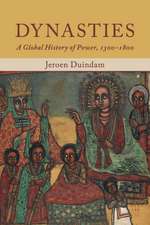The Russian Graphosphere, 1450-1850
Autor Simon Franklinen Limba Engleză Paperback – 17 mar 2021
| Toate formatele și edițiile | Preț | Express |
|---|---|---|
| Paperback (1) | 324.40 lei 43-57 zile | |
| Cambridge University Press – 17 mar 2021 | 324.40 lei 43-57 zile | |
| Hardback (1) | 689.00 lei 38-44 zile | |
| Cambridge University Press – 15 mai 2019 | 689.00 lei 38-44 zile |
Preț: 324.40 lei
Nou
Puncte Express: 487
Preț estimativ în valută:
62.09€ • 67.47$ • 52.19£
62.09€ • 67.47$ • 52.19£
Carte tipărită la comandă
Livrare economică 21 aprilie-05 mai
Preluare comenzi: 021 569.72.76
Specificații
ISBN-13: 9781108716901
ISBN-10: 1108716903
Pagini: 430
Ilustrații: 30 b/w illus.
Dimensiuni: 151 x 228 x 24 mm
Greutate: 0.58 kg
Editura: Cambridge University Press
Colecția Cambridge University Press
Locul publicării:Cambridge, United Kingdom
ISBN-10: 1108716903
Pagini: 430
Ilustrații: 30 b/w illus.
Dimensiuni: 151 x 228 x 24 mm
Greutate: 0.58 kg
Editura: Cambridge University Press
Colecția Cambridge University Press
Locul publicării:Cambridge, United Kingdom
Cuprins
1. Concepts and contexts; 2. Production in the graphosphere, I: primary writing; 3. Production in the graphosphere, II: secondary writing; 4. Scripts and languages of the graphosphere; 5. Places and times of the graphosphere; 6. Aspects of the ecology of the graphosphere; 7. Aspects of authority and status in the graphosphere; 8. (In)conclusion.
Recenzii
'Recommended for libraries supporting Slavic, East European, and Central Eurasian graduate studies. Includes a most extensive bibliography.' B. K. Beynen, Choice
'… insightful … Franklin takes the reader into a world where writing and reading signalled something very different from what they do today.' Marshall Poe, The Times Literary Supplement
'Franklin has written an important book, one that inspires readers to reevaluate past assumptions about the history of material texts, categories of writing and the institutions that determine their value. His is a work whose implications extend beyond the chronological and geographical indicators of its title and that has the potential to establish a new branch of literary and cultural studies beyond the boundaries of our field.' University of Southern California Book Prize in Literary and Cultural Studies Committee
'Franklin introduces the term [graphosphere] as a 'near neologism,' and with it, inaugurates an entire field. Now that he has done so, readers have cause to celebrate. This is a rare book that opens eyes and reveals new vistas for thought, imagination, and scholarship. It is as electrifying in its novelty as it is dazzling in its erudition … The cumulative force of the book allows us to see the concept of the graphosphere emerge out of a haze and solidify as a real and important way to look at the world, to think about culture and history, to unearth new information and gain new perspectives by cutting across familiar categories in unexpected ways.' Valerie A. Kivelson, Canadian-American Slavic Studies
'… insightful … Franklin takes the reader into a world where writing and reading signalled something very different from what they do today.' Marshall Poe, The Times Literary Supplement
'Franklin has written an important book, one that inspires readers to reevaluate past assumptions about the history of material texts, categories of writing and the institutions that determine their value. His is a work whose implications extend beyond the chronological and geographical indicators of its title and that has the potential to establish a new branch of literary and cultural studies beyond the boundaries of our field.' University of Southern California Book Prize in Literary and Cultural Studies Committee
'Franklin introduces the term [graphosphere] as a 'near neologism,' and with it, inaugurates an entire field. Now that he has done so, readers have cause to celebrate. This is a rare book that opens eyes and reveals new vistas for thought, imagination, and scholarship. It is as electrifying in its novelty as it is dazzling in its erudition … The cumulative force of the book allows us to see the concept of the graphosphere emerge out of a haze and solidify as a real and important way to look at the world, to think about culture and history, to unearth new information and gain new perspectives by cutting across familiar categories in unexpected ways.' Valerie A. Kivelson, Canadian-American Slavic Studies
Notă biografică
Descriere
Explores a new approach to the history of writing, and a guide to writing in the history of Russia.






















